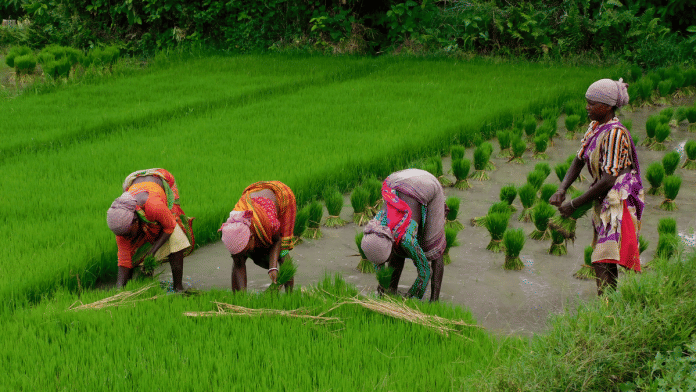New Delhi: Farmers will soon be able to plan agricultural activities according to local weather conditions, as the Centre is planning to start providing gram panchayat-specific weather forecasts to 2.69 lakh such local bodies in the country, ThePrint has learnt.
The India Meteorological Department (IMD), along with Union Ministry of Panchayati Raj and civil society group Kisan Sanchar, is working to provide weather-related information at gram panchayat level.
In January this year, the IMD had launched Panchayat Mausam Sewa — a portal jointly developed by IMD, the panchayati raj ministry and Green Alert Mausam Sewa (an online weather information portal) — to provide weather forecasts at the block level in English and 12 regional languages.
The met department and the ministry are now planning to expand its scope to cover gram panchayats across the country to help farmers in over six lakh villages.
“Currently, we are providing block-level weather forecasts on the portal. IMD is working on providing gram panchayat-level weather forecasts, which will be available shortly,” IMD scientist Sheshakumar Goroshi told ThePrint.
The panchayati raj ministry, it is learnt, plans to link the weather forecast information to its eGramSwaraj portal and Meri Panchayat mobile application so that farmers can receive accurate weather information on their phones.
“IMD is testing the data for gram panchayat-level information. Once implemented, the initiative will be a big boost for the farmers,” a ministry official said.
The Panchayat Mausam Sewa portal provides a forecast in terms of eight weather parameters, such as rainfall, humidity, temperature (day and night), wind speed, wind direction, cloud cover, and so on, for the block.
In addition, it lists out the names of gram panchayats under each block, but doesn’t give panchayat-specific weather-related information yet. Daily block-level forecasts are also sent to the sarpanchs via WhatsApp by Kisan Sanchar, Goroshi explained.
However, while forecast data is available at block level, which, in most parts of the country, is spread over a large area, it may not hold true for all the villages in the block.
Elaborating on how panchayat-specific forecasts will help farmers, Goroshi said that farmers will be able to plan activities, such as sowing, spraying of pesticides, fertiliser application, irrigation, etc. “For example, if there is a prediction of high wind speed, then they can postpone spraying pesticides. The farmers can change their irrigation schedule if there is a rain forecast. All these cues will help farmers plan agricultural operations and save money,” he said.
The panchayati raj ministry is planning another initiative to help boost the income of rural households by installing solar panels using data collected under the SVAMITVA (Survey of Villages Abadi and Mapping with Improvised Technology in Village Areas) scheme.
Rooftop solarisation in villages
After successfully conducting a pilot project last year in three villages in Maharashtra, Chhattisgarh and Uttar Pradesh, the panchayati raj ministry is planning an initiative to assess the potential for rooftop solarisation of houses in 25,000 villages.
The potential project will be implemented under the PM Surya Ghar Muft Bijli Yojana in collaboration with the Ministry of New and Renewable Energy, said senior panchayati raj ministry officials.
Earlier this month, the panchayati raj ministry had asked state governments to take necessary measures for implementation of the PM Surya Ghar Muft Bijli Yojana. Under the scheme, which was launched in February 2024, households can install solar panels and avail themselves of benefits on electricity bills.
A pilot project in Nagepur village in Uttar Pradesh’s Varanasi district last year showed that close to 15,000 500-watt solar panels can be installed in the village to generate 7.5 megawatts of solar power for six hours daily.
Similarly, in Amora (Chhattisgarh) and Yerol (Maharashtra), it was found that it would be possible to generate 6.3 and 3.5 megawatts, respectively, for six hours daily by installing solar panels, ThePrint had reported in November last year.
A senior ministry official said, “The implementation of the scheme would contribute to the adoption of clean energy and also create a new source of revenue for panchayati raj institutions.”
The SVAMITVA data is expected to come in handy in demand aggregation for the implementation. Till date, 3.16 lakh villages have been covered under the SVAMITVA scheme and 2.13 cr property cards have been issued in 1.3 lakh villages.
“Now that we have the data about each property in surveyed villages and digital images of it, it will be easy to calculate the rooftop space, which can be used for solar panel installation,” said a senior ministry official.
(Edited by Mannat Chugh)
Also Read: Modi govt plans to launch ‘Aspirational Urban Local Bodies’ initiative in tier 2 & tier 3 cities






